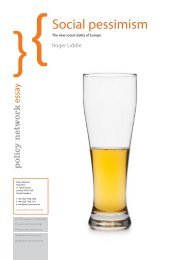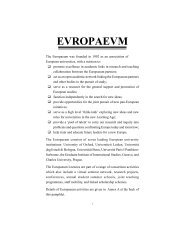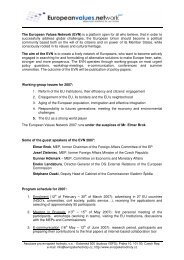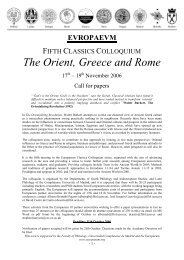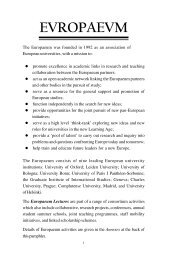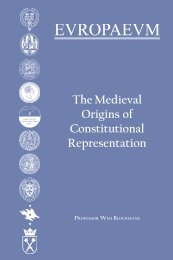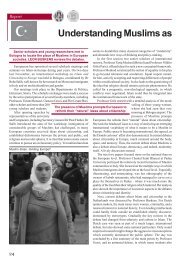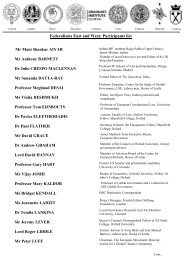Authors Iain Begg | Gabriel Glöckler | Anke Hassel ... - The Europaeum
Authors Iain Begg | Gabriel Glöckler | Anke Hassel ... - The Europaeum
Authors Iain Begg | Gabriel Glöckler | Anke Hassel ... - The Europaeum
Create successful ePaper yourself
Turn your PDF publications into a flip-book with our unique Google optimized e-Paper software.
Nevertheless, the combination of activation policies and placing the low<br />
skilled in the labour market has generally led to an increase of low paid<br />
employment, particularly in the service sector. While this has contributed<br />
to a steady rise in employment levels throughout the EU, the question<br />
remains whether low pay can be contained or reduced by minimum wages<br />
without detrimental effects on employment, or whether policies should<br />
focus on guaranteeing minimum incomes which consist of a combination<br />
of pay and transfer payments. In any case, it is important to stress that<br />
first, both low pay and in-work poverty are highly related and second,<br />
that there is no direct connection to employment levels. In other words,<br />
countries with high numbers of workers in low paid employment and at<br />
in-work poverty risk can also be countries with relatively low employment<br />
levels. Or put the other way round: it is possible to achieve both high levels<br />
of employment and relatively well paid jobs at the lower end of the labour<br />
market.<br />
Do statutory minimum wages<br />
diminish in-work poverty?<br />
<strong>The</strong> debate on minimum pay and standards of living has been resumed<br />
at the EU institutional level as well as at the national levels with various<br />
successes. While from an academic perspective, the demand for a European<br />
minimum wage has been discussed more thoroughly 9 there is also an<br />
increasing number of voices at the European level asking for a European<br />
minimum wage, such as Jean-Claude Juncker. This topic was resumed<br />
during the German presidency in January 2007 and put on the agenda<br />
of the EU Ministers for Employment and Social Affairs. <strong>The</strong> concluding<br />
document entails a call for fair and adequate wage setting mechanisms.<br />
Statutory minimum wages are primarily a sign of the weakness of collective<br />
bargaining systems. Countries with comparatively weak collective<br />
bargaining institutions and weak social partner organisations tend to have<br />
statutory minimum wage policy. <strong>The</strong> EU member states without statutory<br />
minimum wage are also among the countries with the highest collective<br />
bargaining coverage rates, which leads to the conclusion that in these<br />
countries, the majority of employees are covered by a sectoral minimum<br />
wage agreement. 10 Moreover, minimum wages that are determined by<br />
collective agreements tend to be higher than statutory minimum wages.<br />
While collective bargaining institutions, particularly the coverage of<br />
employees by wage agreements, have a dampening effect on the in-work<br />
poor, the effects of the statutory minimum wage on the incidence of<br />
low pay are harder to establish. In any case, countries with a statutory<br />
Chapter 9 – <strong>Anke</strong> <strong>Hassel</strong> 137



